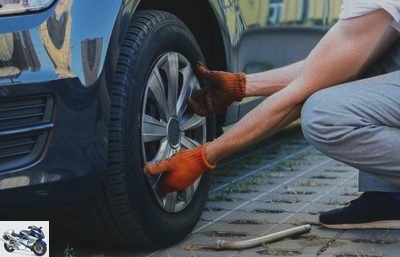How to change your tires yourself ?

There are many reasons why you will need to change the tires on your car. It can be, among other things, a puncture, a change of season (switching from winter tires to summer tires or vice versa) and wear of your tires..
Since motorcyclists are also sometimes, willy-nilly, motorists, our partner centraltires.fr teaches you or reminds you how to change the tires on your car. Good reading !
Note that each manufacturer may recommend a different lifespan depending on the specific vehicle application, and you should stick to them. Whatever the reason for a tire change, the procedure is fairly straightforward. Armed with a few basic tools and our step-by-step guide, you will be able to successfully complete this essential task yourself..
Good reflexes to have before changing the tires
Here are some tips to follow to change your tires safely:
- Park your car on a flat surface. Indeed, you should never change tires on a slope.
- Apply the parking brake and put the vehicle in park mode (if it is automatic) or engage a gear (if it is manual).
- Make sure no one is in the vehicle.
- Use chocks or heavy objects (wood, bricks, large stones) on each side of the wheel, diagonally to the one you are changing.
- If you have a flat tire, park in a safe place, off the road, and turn on your car’s hazard warning lights..
- If you change the tires on your car because of wear or because they are damaged, at the same time check whether the spare tire is damaged or too old. Replace it with a new one if necessary. You can get good quality tires from specialist sites such as .

The steps of a tire change
Once you have made sure that you have parked your car in a safe place and that you have immobilized your car, you can now proceed with the tire change by following the following steps.
- Remove the hubcap or the wheel cover if there is one.
- Loosen while being careful not to remove the lug nuts. Be sure to loosen them enough to make them easier to remove after you lift the car off the ground. Are the wheel nuts too tight? You can carefully press down on the key, ensuring that it is in a horizontal position, with a cross key.
- Raise the car by placing a jack underneath. If you don’t know where, your car’s manual will tell you the correct position to place it. Slowly and smoothly lift your car until the wheel to be changed is about 15 cm from the ground.
- Remove your lug nuts. Now that they are loose, you can remove them completely by hand. Be sure to put them in a safe place so as not to lose them !
- Remove the wheel to be changed. Pull it towards you with both hands. Roll her on her side and get her out of the way.
If you are changing a full set of tires and going to put them away, label each one with a piece of chalk as you remove them. This way you can know where each of them was mounted and take that into account if you plan to put them back in the future..
- Fit the new wheel and tighten your lug nuts. At first, do this only by hand. The nuts should always be tightened one after the other in a diagonally opposite order, i.e. by tightening one first, then the other diagonally, but not directly alongside.
- Lower the vehicle and tighten the lug nuts with your wrench. Again, just like when you loosened the nuts, you can carefully apply additional pressure to the horizontally positioned cross key as you tighten them. Normally, a torque wrench should be used with the correct force, otherwise the bolts will be damaged by elongation..
- Reassemble the hubcap or wheel cover, and you’re done.
How to know when it’s time to replace your tires ?
There are three things you need to consider when deciding whether or not it’s time to replace your tires. These are the tread wear, exposure and age of the tire..
Tread wear
The most important reason to worry about tread wear is safety. When your tire treads are worn out, your car may react badly in adverse weather conditions like rain and snow. With good treads, your car will have better grip on the road.
In addition, having insufficient tread, such as riding with a tear or hernia is prohibited. You risk a 4th class traffic violation by committing this traffic violation. Finally, worn treads can cause premature wear to other parts of your car..
To check the tread wear, the wear indicator, present on all tires, will be your best ally !
Heat exposure of your tires
Exposure to the sun’s heat and ultraviolet rays can cause structural changes to your tires such as hernias. These changes are generally not of concern in places with moderate climates. However, in warmer regions like those in the south of France, you will need to pay special attention, even more if your car "sleeps" outside..
Tire age
How old are your tires? Regardless of the wear and tear on the tread, vehicle manufacturers generally recommend replacing your tires after six years or less, even for low-speed vehicles. Check the manufacturer’s recommendations for your specific tires, and follow the recommendations. Your safety is at stake !
Tyreleader.fr
Related articles
-
Practice – Your 3-day invitation to the Bol d’Or 2019! –
Your 3-day invitation to the Bol d’Or 2019 ! As every year, the Journal moto du Net is pleased to invite you to the Bol d’Or on September 20, 21 and 22,…
-
Practical guides – Motorcycle tires: practical advice for riding well –
Motorcycle tires: practical advice for driving well Too often neglected by motorcyclists, the tire supports substantial constraints which vary according…
-
44th Beaujolais Rally: Manoel Delaval ahead of the pack ! Brilliant winner of this 4th round of the 2009 French Rally Championship, Delaval strengthens…
-
Practice – Your invitation for the 2019 French Moto GP Grand Prix –
Your invitation for the 2019 French Moto GP Grand Prix Like every year, Le Journal moto du Net is pleased to invite its subscribers to the French MotoGP…
-
Practice – Your invitation to the 2018 French Moto GP –
Your invitation to the 2018 French Moto GP Like every year, Site is pleased to invite its readers to the Grand Prix de France MotoGP ! Update: this offer…
-
Practical guides – Maintenance, checks: how to prepare your motorcycle for sunny days –
Maintenance, checks: how to prepare your motorcycle for sunny days Take the motorcycles out of the garages: the beautiful days are back! But before going…
-
Motorcycle tires: everything you need to know to choose them well and maintain them
April 3, 2018 Making the best choice of tires is about ensuring your safety. Depending on the two-wheeler and the way it is driven, road travel, sporty…
-
MotoGP – Moto GP Aragon – FP3 practice: a hit in the water … –
BMW R 850 and R 1100 GS test News from Duckburg For years, BMW has set the standard for large touring enduros with the R 1100 GS. Now the Munich-based…
-
Tires – New Pirelli Angel ST motorcycle tire with two-face tread –
New Pirelli Angel ST motorcycle tire with two-face tread Unveiled during the press conference presenting the 2009 Superbike World Championship, the Angel…
-
New motorcycle tire: discovery of the Pirelli Diablo Rosso III Pirelli has just unveiled its new supersport tire: the Diablo Rosso III. Designed for the…